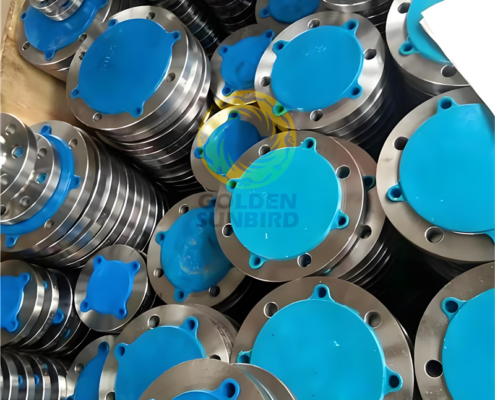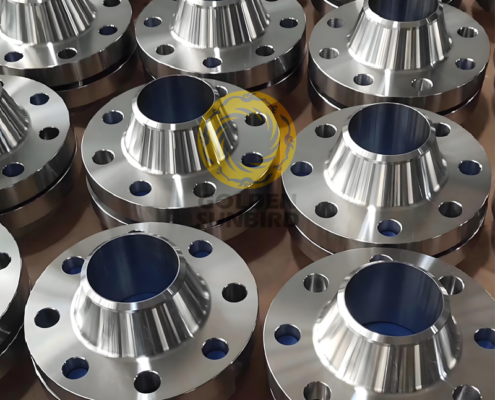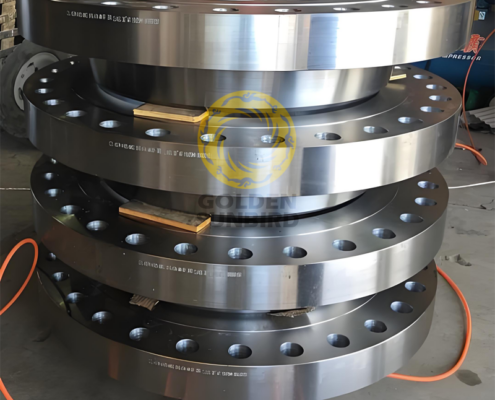Golden Sunbird Metals is a professional supplier of stainless steel flanges. We offer high-quality stainless steel pipe flanges at wholesale prices for oil and gas, chemical processing, power generation, aerospace, marine, and nuclear, serving as critical components for connecting piping systems and ensuring leak-tight seals in corrosive environments, high-temperature conditions, and applications requiring resistance to stress corrosion cracking and erosion. Our products stand out for their durability, corrosion resistance, and superior performance under challenging environments. If you want to buy stainless steel pipe flanges in bulk or find a supplier of customized stainless steel flanges or a solution company, please don’t hesitate to contact us at [email protected].
FAQs
What are stainless steel flanges and why are they used?
Stainless steel flanges are a type of pipe fitting used to connect pipes, valves, pumps, or other piping components together in a piping system. They are removable flanges, unlike buttweld fittings that are permanently welded to the pipes. Here’s a breakdown of why stainless steel flanges are commonly used:
-
Leak-Proof Connections: Flanges use gaskets sandwiched between two mating surfaces to create a tight seal, preventing leaks in the piping system. This is crucial for applications containing fluids or gases under pressure.
-
Removable Connections: Unlike welded fittings, flanges allow for disassembly of the piping system for maintenance, inspection, or replacement of components. This is advantageous for future modifications or repairs to the system.
-
High-Pressure Applications: Due to the bolted connection method, stainless steel flanges can be designed to handle high-pressure applications. They come in various pressure classes to suit different pressure requirements.
-
Versatility in Pipe Diameters: Flanges are available in various sizes to accommodate various pipe diameters. This allows for flexibility in connecting pipes of different sizes within a piping system.
-
Alignment: Flanges help ensure proper alignment of pipes and components during assembly. The bolting pattern forces the flanges together, ensuring a precise connection.
Here are some additional points to note about stainless steel flanges:
-
Flange Types: There are various types of stainless steel flanges, each with its own advantages and applications. Common types include threaded flanges, socket weld flanges, and lap joint flanges.
-
Flange Facings: A flange’s sealing surface can have different configurations, such as a raised face or a flat face. The choice of facing depends on the gasket type and application requirements.
-
Bolting Materials: The bolts used with stainless steel flanges should be compatible with the flange material grade to ensure optimal corrosion resistance and joint strength.
-
Gasket Selection: The type of gasket between the flanges is crucial for achieving a leak-proof seal. Gasket material selection depends on pressure, temperature, and the conveyed fluid.
Overall, stainless steel flanges offer a reliable and versatile solution for connecting piping components in various industrial applications due to their removability, leak-proof sealing, and ability to handle high pressures.
Can you customize stainless steel flanges to specific designs?
For sure! Stainless steel flanges can be customized to specific designs. Customization allows you to meet unique requirements for particular applications and environments.
Size and Dimensions: Upon your drawing requirements
Flange Types: weld neck, slip-on, blind, socket weld, threaded, lap joint, orifice flanges
Material Composition: Can be tailored to meet specific corrosion resistance, temperature, and strength requirements
Surface Treatment and Coatings: Polishing, anodizing, or passivation.
Drilling Patterns and Bolt Holes: Upon to your drawing requirements
Pressure Ratings: Customization allows for meeting specific pressure and temperature ratings.
Unique Shapes and Designs: Custom shapes and specialized designs can be created, including complex geometries or integrated features.
Compliance with Standards: Even with customization, flanges can be designed to comply with industry standards like ASME, ANSI, or other relevant regulations.
What types of stainless steels are available for flanges?
Several stainless steel grades are commonly used for flanges, each offering different properties for various applications. Here’s an overview of the most common types:
-
Type 304 (UNS S30400): This versatile and widely used austenitic stainless steel grade offers good corrosion resistance, formability, and weldability. Type 304 flanges are suitable for a broad range of chemical, food processing, and pharmaceutical applications involving moderate pressure and temperatures.
-
Type 316 (UNS S31600): Similar to 304, but with the addition of molybdenum, Type 316 provides enhanced corrosion resistance, particularly in environments with chlorides or other harsh chemicals. Type 316 flanges are commonly used in chemical processing, marine environments, pulp and paper mills, and offshore oil and gas applications where superior corrosion resistance is required.
-
Type 304L (UNS S30403): This is a low-carbon variant of Type 304. The lower carbon content improves its weldability, making it suitable for applications where welding is a primary concern. Type 304L flanges are often used in food processing and pharmaceutical applications where good weldability and corrosion resistance are important.
-
Type 316L (UNS S31603): Similar to Type 316, but with lower carbon content, Type 316L offers improved weldability while maintaining excellent corrosion resistance. Type 316L flanges are commonly used in chemical processing, oil and gas applications, and cryogenic environments where weldability and superior corrosion resistance are crucial.
-
Alloy 20 (UNS N08020): This high-nitrogen austenitic stainless steel grade is known for its superior strength and resistance to pitting corrosion in chloride environments. Alloy 20 flanges are used in seawater applications, pulp and paper mills, and chlorine handling systems.
Here are some additional factors to consider when choosing the right stainless steel grade for your flanges:
-
Pressure and Temperature: Your piping system’s pressure and temperature rating will influence the appropriate flange grade. Higher pressure or temperature applications might require a stronger, more temperature-resistant grade like Alloy 20.
-
Fluid Compatibility: The type of fluid being conveyed through the pipes should be considered. Some chemicals might require a specific grade of stainless steel with superior resistance to that fluid.
-
Cost: Stainless steel grades like 304 and 304L are generally more cost-effective than molybdenum-containing grades like 316 and 316L or high-alloy grades like Alloy 20.
-
Regulations: Certain industries might have specific regulations dictating the type of stainless steel used in flange applications.
By considering these factors and consulting with flange manufacturers or materials specialists, you can select the most suitable stainless steel grade for your flange application.
How does Golden Sunbird Metals ensure the quality of its stainless steel flanges?
Golden Sunbird Metals ensures the quality of its stainless steel flanges through rigorous quality assurance measures. These include adhering to industry standards, conducting thorough testing, and ensuring compliance with certifications like ISO. The company specializes in producing, selling, and exporting various stainless steel products, ensuring each meets the specifications.
What industries benefit from using stainless steel flanges?
Due to their versatility, durability, and leak-proof sealing capabilities, stainless steel flanges find applications in a wide range of industries. Here are some of the key beneficiaries:
Chemical and Petrochemical Processing:
- Flanges connect pipes, valves, and vessels transporting chemicals, fluids, and gases.
- The corrosion resistance of stainless steel grades like 316L ensures the safe handling of harsh chemicals.
- Flanged connections allow for easier disassembly during maintenance or cleaning of process equipment.
Oil and Gas Industry:
- Stainless steel flanges are used in onshore and offshore applications for pipelines, well casings, and other equipment.
- Their high-pressure tolerance and ability to withstand harsh environments make them suitable for oil and gas exploration, transportation, and refining.
- The removability of flanges facilitates the maintenance and repair of equipment.
Food and Beverage Processing:
- The smooth surface and cleanability of stainless steel flanges make them ideal for hygienic piping systems.
- They are used to connect pipes to transfer liquids like milk, beer, and juice.
- Flanges comply with strict sanitary requirements to ensure product quality and safety.
Water and Wastewater Treatment:
- Stainless steel flanges resist corrosion from chlorine and other chemicals used in water treatment.
- They are used in piping systems for clean water distribution and wastewater treatment facilities.
- Disassembling flanged connections allows for easier cleaning and maintenance of treatment equipment.
Power Generation:
- Flanges connect pipes for transporting water, steam, and other fluids, including nuclear facilities, across power plants.
- Stainless steel offers good resistance to high temperatures and pressure in power generation processes.
- Flange design allows for thermal expansion and contraction within the piping system.
Pharmaceutical Industry:
- Like food processing, flanges ensure clean and sterile environments for transferring pharmaceutical solutions.
- The corrosion resistance of stainless steel grades like 316L is crucial for handling sensitive pharmaceutical products.
- Flanges comply with strict regulations governing hygiene and cleanliness in pharmaceutical manufacturing.
Marine Industry:
- Due to their resistance to saltwater corrosion, stainless steel flanges are used extensively in shipbuilding and offshore applications.
- They are found in piping systems for engines, ballast water, and other critical functions on ships and offshore platforms.
- Flange connections enable easier disassembly for repairs at sea.
Other Industries:
- Stainless steel flanges are also used in various other sectors, such as pulp and paper processing, textile manufacturing, and chemical weapon processing facilities, due to their durability and corrosion resistance in harsh environments.
How can clients ensure their stainless steel flanges needs are accurately met?
Here are some key steps clients can take to ensure their stainless steel flange needs are accurately met:
1. Define Project Requirements:
- Application: Identify the purpose of the flanges. What fluids will they be conveying?
- Pressure and Temperature: Specify the maximum pressure and temperature rating required for the piping system.
- Pipe Size and Schedule: Determine the diameter and wall thickness (schedule) of the pipes to which the flanges will be connected.
2. Choose the Right Flange Type and Grade:
- Flange Selection: Consider factors like pressure rating, ease of assembly/disassembly, and future maintenance needs. Consult with a supplier or engineer to choose the appropriate flange type (threaded, socket weld, lap joint, etc.)
- Stainless Steel Grade: Select a grade that is compatible with the fluids being conveyed and resilient in the operating environment (e.g., Type 316 for harsh chemicals).
3. Specify Flange Standards and Certifications:
- Standards: Ensure the flanges comply with relevant industry standards, such as ASME (American Society of Mechanical Engineers), for dimensions, pressure ratings, and material properties.
- Certifications: If required for your application, specify any certifications for the flanges, such as material traceability documents.
4. Communicate Clearly with Suppliers:
- Provide Detailed Information: Communicate all project requirements, including application details, desired flange type and grade, pressure/temperature ratings, and any specific standards or certifications needed.
- Request Datasheets and Certificates: Ask the supplier for datasheets on the offered flanges that detail material properties, pressure ratings, and dimensions. If applicable, request any relevant certificates.
5. Consider Additional Factors:
- Budget: Stainless steel grades and flange types can vary in cost. Discuss budget constraints with the supplier to find an optimal balance between performance and cost.
- Delivery Time: Specify your required delivery timeframe and ensure the supplier can meet it.
- Quality Assurance: Inquire about the supplier’s quality control procedures to ensure the flanges meet the specified standards.
Additional Tips:
- Work with reputable suppliers: Choose suppliers with a good track record in supplying high-quality stainless steel flanges.
- Seek professional guidance: If unsure about specific details, consider consulting with an engineer experienced in piping systems to ensure you choose the most suitable flanges for your project.
By following these steps and carefully communicating your needs, clients can increase their chances of obtaining stainless steel flanges that meet their specific application requirements and ensure a successful project outcome.






